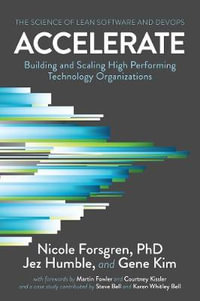| Foreword | p. xiii |
| Preface | p. xv |
| Acknowledgments | p. xvii |
| Introduction | p. xix |
| About the Authors | p. xxiii |
| List of Commonly Used Acronyms | p. xxv |
| What Does IT Contribute to the Business? | |
| What Should the Business Expect from IT? | p. 3 |
| Information for Decisions | p. 5 |
| Value for Money | p. 6 |
| Risk Management | p. 7 |
| Innovation | p. 8 |
| Process | p. 9 |
| Responsiveness | p. 11 |
| Summary | p. 12 |
| References | p. 12 |
| How Do I Measure the Value of IT? | p. 13 |
| What Is Value? | p. 13 |
| Why Is It Important to Measure IT Value? | p. 15 |
| Financial Value Measures | p. 16 |
| Total Cost of Ownership (TCO) | p. 16 |
| Return on Investment (ROI) | p. 16 |
| Economic Value Added (EVA) | p. 17 |
| Real Options Valuation (ROV) | p. 17 |
| Return on Assets (ROA) | p. 18 |
| Return on Infrastructure Employed (ROIE) | p. 18 |
| Non-Financial Value Measures | p. 19 |
| Multi-Dimensional Value | p. 19 |
| Strategic Value | p. 21 |
| Using IT Value Measurements for Decisions | p. 25 |
| Dashboards | p. 26 |
| The Business Case | p. 27 |
| Value Visualization | p. 29 |
| Summary | p. 31 |
| References | p. 31 |
| How Much IT Is Enough? | p. 33 |
| ROI or Return on Investment for IT Spending | p. 34 |
| IT Spending as a Percentage of Gross Company Revenue | p. 36 |
| IT Distribution Analysis | p. 36 |
| Organizational Evaluation | p. 39 |
| Containing Cost Versus Innovation | p. 40 |
| Summary | p. 42 |
| References | p. 42 |
| Am I Paying Too Much for IT? | p. 43 |
| What Is a Budget? | p. 44 |
| Defining a Budget for IT | p. 44 |
| IT as a Percent of Revenue | p. 46 |
| IT as a Percent of Total Operating Expenses (Opex) | p. 46 |
| IT as a Strategic Business Partner | p. 47 |
| IT Poised to Enable the Business Strategy | p. 51 |
| Capitalizing IT Expenses | p. 52 |
| Monthly Budget Review | p. 54 |
| Monthly Project Review | p. 55 |
| Summary | p. 56 |
| References | p. 56 |
| Why Should We Care About it Governance? | |
| Who Governs IT? | p. 59 |
| What Is IT Governance? | p. 59 |
| Key Elements of IT Governance | p. 60 |
| IT Principles Decisions | p. 60 |
| IT Architecture Decisions | p. 61 |
| IT Infrastructure Decisions | p. 62 |
| Business Needs Decisions | p. 63 |
| IT Investment and Prioritization Decisions | p. 63 |
| Decision Input and Decision Making Models | p. 64 |
| Summary | p. 69 |
| Reference | p. 70 |
| What Models Should IT Use? | p. 71 |
| Capability Maturity Model Integration (CMMI) | p. 72 |
| Control Objectives for Information and Related Technology (COBIT) | p. 77 |
| IT Infrastructure Library (ITIL) | p. 79 |
| Service Strategy Processes | p. 84 |
| Service Design Processes | p. 86 |
| Service Transition Processes | p. 87 |
| Service Operation Processes | p. 89 |
| Continual Service Improvement Processes | p. 89 |
| International Organization for Standardization (ISO) | p. 90 |
| Project Management | p. 92 |
| Six Sigma | p. 93 |
| Summary | p. 98 |
| References | p. 98 |
| Are We Outsourcing Effectively? | p. 99 |
| Why Should We Outsource or Why Are We Outsourcing? | p. 100 |
| What Are Our Competitors Outsourcing Today? | p. 101 |
| What Should We Be Outsourcing? | p. 105 |
| Is Our Governance of Outsourcing Appropriate? | p. 107 |
| Are We Engaging With Our Outsourcing Vendors Appropriately? | p. 111 |
| Are Our Service Level Agreements (SLAs) Driving the Behavior We Need? | p. 115 |
| The SLA Framework | p. 117 |
| Identifying Service Level Measures | p. 117 |
| Measuring Levels of Service | p. 118 |
| Monitoring Performance | p. 119 |
| Summary | p. 120 |
| References | p. 120 |
| What Tools Should IT Use? | p. 121 |
| What Are the Business Benefits of Using IT Tools? | p. 122 |
| What Are the Business Risks of Using IT Tools? | p. 124 |
| How Will IT React to Business Questions About Tools? | p. 125 |
| An IT Software Tools Taxonomy | p. 127 |
| Service Management Tools | p. 127 |
| Service Support Tools | p. 128 |
| Service Delivery Tools | p. 132 |
| What Criteria Should We Use for Evaluating Software Tools? | p. 133 |
| What Are the Best Options for Delivering IT Tools to End Users? | p. 134 |
| Summary | p. 135 |
| References | p. 135 |
| Why Should We Measure It Performance? | |
| How Do I Measure IT Performance? | p. 139 |
| IT Value Contribution | p. 140 |
| Four Key Performance Measures (+ One) | p. 142 |
| Cost | p. 143 |
| Quality | p. 143 |
| Duration | p. 143 |
| Customer Satisfaction | p. 144 |
| The Missing Measure: Size | p. 144 |
| Function Point Analysis | p. 146 |
| Combing the Key Performance Measures | p. 147 |
| Cost and Size | p. 147 |
| Duration and Size | p. 148 |
| Quality and Size | p. 148 |
| Effort and Size Productivity | p. 149 |
| A Successful Measurement Program | p. 150 |
| Determining the Source of the Data | p. 150 |
| Ensuring the Integrity of the Data | p. 151 |
| Reporting the Data | p. 151 |
| Summary | p. 152 |
| References | p. 153 |
| Is IT Operating Effectively? | p. 155 |
| Introducing the Measurement Model | p. 155 |
| Quantitative Data | p. 156 |
| Qualitative Data | p. 158 |
| Collecting the Data | p. 160 |
| Quantitative Data Collection | p. 161 |
| Qualitative Data Collection | p. 161 |
| Analyzing the Data and Reporting the Results | p. 163 |
| Measuring Effectiveness | p. 172 |
| Improved Estimating Practices | p. 173 |
| Summary | p. 175 |
| References | p. 175 |
| Where Are We in Relation to Industry Peers? | p. 177 |
| Comparing to Industry Data | p. 178 |
| Where Does the Data Come From? | p. 178 |
| Comparative Data Points | p. 180 |
| Developing a Baseline | p. 180 |
| Initialization | p. 181 |
| Establishing Baseline Objectives | p. 181 |
| Defining Baseline Deliverables | p. 181 |
| Identifying Key Data Elements | p. 182 |
| Data Collection | p. 182 |
| Defining the Data Collection Process | p. 182 |
| Collecting Quantitative Data | p. 182 |
| Collecting Qualitative Data | p. 182 |
| Analysis | p. 183 |
| Establishing Performance Profiles | p. 183 |
| Establishing Internal Benchmarks | p. 183 |
| Comparing Findings to Industry Data | p. 183 |
| Project Performance Baseline | p. 183 |
| The Baseline Process | p. 184 |
| The Collection Process | p. 184 |
| Quantitative Data | p. 184 |
| Qualitative Data | p. 185 |
| Baseline Deliverables | p. 185 |
| Analysis of Process Strengths and Weaknesses | p. 187 |
| Not-for-Profit Industry Data Sources | p. 189 |
| ISBSG | p. 189 |
| Software Engineering Institute Data | p. 190 |
| The Importance of Auditing | p. 191 |
| Objectives of an Audit | p. 192 |
| Scope of the Audit | p. 192 |
| The Auditing Process | p. 193 |
| Problem Resolution | p. 194 |
| Summary | p. 194 |
| References | p. 195 |
| How Can We Do IT Better? | p. 197 |
| The IT Industry Context | p. 197 |
| Case Studies | p. 199 |
| Large Financial Institution | p. 200 |
| Mid-Size Insurance Company | p. 202 |
| Large Service Organization | p. 203 |
| Performance Modeling | p. 204 |
| Summary | p. 205 |
| How Should We Change? | |
| How Can We Manage IT Changes? | p. 209 |
| The Need for Change Management | p. 209 |
| Types of Change | p. 210 |
| Seven Principles of Managing Change | p. 211 |
| Two Levels of Management Support | p. 211 |
| Proper Funding | p. 212 |
| The Business Case | p. 213 |
| Setting and Managing Expectations | p. 213 |
| It's About the People | p. 214 |
| Communicate, Communicate, Communicate | p. 214 |
| Measurement Is Key | p. 214 |
| Managing Resistance | p. 215 |
| Using a Change Agent or a Coach | p. 217 |
| Summary | p. 218 |
| Further Readings | p. 218 |
| How Should IT Manage Risk? | p. 219 |
| Why Perform Risk Planning? | p. 220 |
| How to Begin Risk Planning | p. 221 |
| How Does Security Relate to Risk Planning? | p. 225 |
| What Legislation Has Affected Risk Planning, and Why? | p. 226 |
| Sarbanes-Oxley Act of 2002 | p. 226 |
| Health Insurance Portability and Accountability Act of 1996 (HIPAA) | p. 227 |
| Gramm-Leach-Bliley Act of 1999 (GLB Act) | p. 228 |
| Summary | p. 229 |
| Reference | p. 229 |
| How Should IT Manage Its People? | p. 231 |
| What Should You Expect From Your CIO? | p. 232 |
| Leadership | p. 232 |
| Management Skills | p. 233 |
| Communication Skills | p. 234 |
| Technical Expertise | p. 235 |
| Business Expertise | p. 235 |
| Vision - Ability to Create and Manage Change | p. 236 |
| Ability to Hire, Develop, and Retain High-Quality IT Professionals Who Can Work Together | p. 237 |
| International or Global Experience | p. 239 |
| Industry-Specific Experience | p. 240 |
| Relationship Skills | p. 240 |
| IT Staff as Assets | p. 240 |
| IT Staff and Change | p. 243 |
| IT Staff as Stakeholders | p. 245 |
| Summary | p. 248 |
| References | p. 248 |
| What Should IT Expect From the Business? | p. 249 |
| It's the Relationship That Matters | p. 249 |
| Develop an Operating Model | p. 250 |
| Statement of Commitment | p. 253 |
| Summary | p. 254 |
| References | p. 254 |
| Index | p. 255 |
| Table of Contents provided by Ingram. All Rights Reserved. |
























